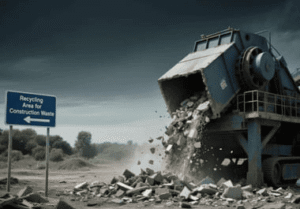
Resourceful Treatment of Construction Waste Brick Slag:
Exploring a New Path to Green Development
- With the acceleration of urbanization, high-rise buildings are rising, while the volume of construction waste continues to climb.
- According to statistics, more than 10 million tons of construction waste is generated annually, of which brick slag accounts for more than 40%.
- How to efficiently and environmentally friendly treatment of these “misplaced resources” has become a key proposition for sustainable urban development.

Brick slag in construction waste is often mixed with concrete, wood and plastic
First, the urgency of construction waste and brick slag treatment
- China – ASEAN open cooperation of the frontier city, in recent years, the infrastructure and old city renovation projects are intensively promoted.
- However, the traditional ways of construction waste disposal – such as simple landfills or open piles – not only take up a large amount of land resources, but also cause environmental problems such as dust pollution and groundwater seepage.
- Brick slag, as a hard and large component of construction waste, will become a “stubborn burden” in the urban ecological chain if it cannot be effectively utilized.
- A demolition project, for example, a single project to produce 50,000 tons of brick dregs, if the direct landfill needs to consume nearly 10 acres of land.
- Through resource treatment, these brick slag can be converted into recycled aggregates or environmentally friendly building materials, to achieve “waste to treasure”.
Second, Nanning brick slag treatment of the three core difficulties
Complex composition, high cost of separation
Brick residue in construction waste is often mixed with concrete, wood, plastic, etc. Traditional sorting technology is inefficient and costly. Some enterprises try to introduce AI intelligent sorting equipment, but the initial investment is large, which is difficult for small and medium-sized enterprises to bear.

Threshold of recycling technology
If the aggregate formed after crushing brick slag is directly used in low-grade concrete, it may lead to safety hazards due to insufficient strength. Currently, the R&D of high-strength recycled brick technology, by adding curing agent to enhance the performance, but the commercial application still needs time.
Insufficient dual-driven policy and market
However, special subsidies and tax incentives for brick slag disposal have not yet been refined. Some enterprises have a wait-and-see attitude towards technology upgrading due to limited profit margins.
.
.
Mobile Crushing Production Line
In the pilot project, the enterprise adopts the mode of “on-site crushing + local utilization”, crushing the brick residue at the demolition site directly into recycled aggregates with different particle sizes, such as 0-5mm, 5-10mm, etc., which can be used for filling the road base or permeable brick production. This model reduces transportation costs by more than 30%, while reducing the risk of secondary pollution.
.
.
Automated production of recycled bricks
An environmental enterprise introduced a fully automated brick-making machine to mix brick residue with cement and industrial waste in proportion to produce environmentally friendly bricks with a compressive strength of 15MPa. These products have been widely used in municipal trails, landscaping construction, annual consumption of more than 200,000 tons of brick slag.
“Internet+Recycling” Platform
The construction waste information supervision system matches the demand of demolition projects and recycling enterprises through big data. For example, a construction site has supplied 8,000 tons of brick residue to a downstream brick factory through the platform, saving nearly 500,000 yuan in disposal costs.
IV. Typical Case: Insights from Resourcefulness Treatment Center
As the first comprehensive treatment base for construction waste, the project has an annual treatment capacity of 1 million tons, of which 60% is brick slag. Its successful experience can be summarized as:
Government-enterprise cooperation model: the government provides land and policy support, and the enterprise is responsible for technical input and operation; Closed-loop industrial chain: the crushed aggregate is directly supplied to the building materials enterprises in the park, forming an integrated chain of “treatment-production-sale”;
public participation mechanism: through community publicity and reward points, residents are encouraged to separate construction waste.
After two years of operation, the amount of illegal dumping of construction waste in the surrounding area dropped by 70%, and more than 200 jobs were created, making the project a benchmark case of green development.
V. Future outlook: from “passive treatment” to “active recycling”
In order to realize the efficient use of construction waste and brick slag, it is still necessary to collaborate with many parties:
Policy level: Refine the financial subsidy standard, and include the resource products into the government procurement catalog;
technical level: promote cooperation between industry, academia and research, and research and develop low-cost, high-value-added recycled building materials;
public level: strengthen environmental education and guide construction units and citizens to practice waste classification.
As the head of the Environmental Protection Bureau said, “Construction waste is not the end, but a new starting point for resource recycling.” Driven by the goal of “double carbon”, the resource treatment of brick residue will become an important hand in the construction of eco-livable cities.





